fuel BUICK PARK AVENUE 1993 Owners Manual
[x] Cancel search | Manufacturer: BUICK, Model Year: 1993, Model line: PARK AVENUE, Model: BUICK PARK AVENUE 1993Pages: 340, PDF Size: 18.17 MB
Page 14 of 340
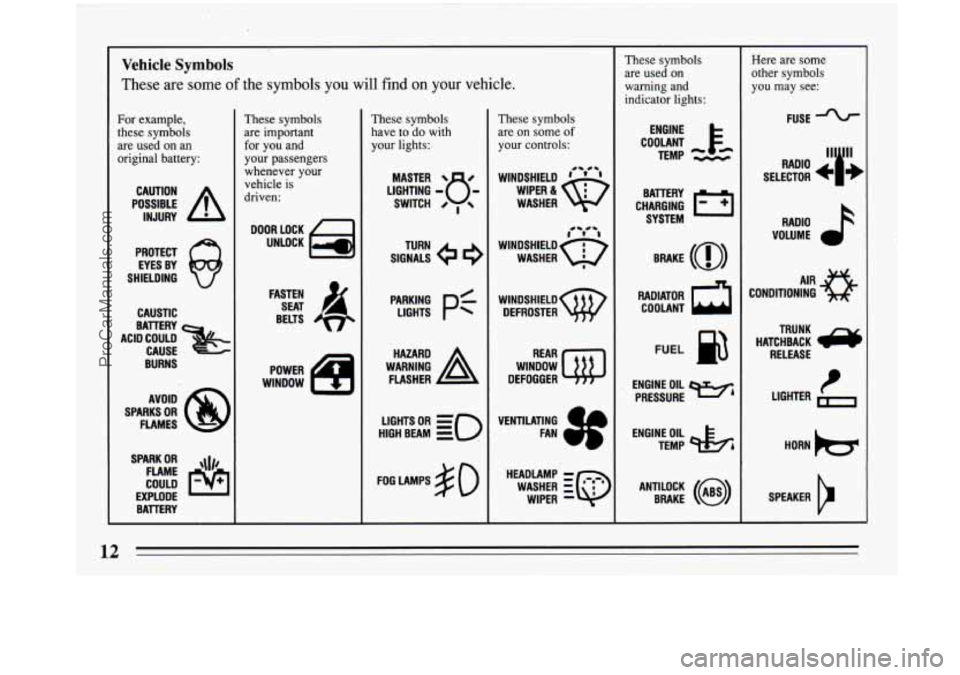
!
!
Vehicle Symbols
These are some of the symbols you will find on your vehicle.
For example,
these symbols
are used on an
original battery:
POSSIBLE A
CAUTION
INJURY
PROTECT
EYES BY
SHIELDING
CAUSTIC
ACID COULD BATTERY
CAUSE
BURNS
SPARK
OR ,\I/,
COULD FLAME
EXPLODE BATTERY
These symbols are important
for you and
your passengers
whenever your
vehicle is
driven:
DOOR LOCK
UNLOCK
FASTEN SEAT
4
BELTS
POWER
WINDOW
These symbols have to do with
your lights:
LIGHTS PC
HIGH BEAM OR = =o
FOG LAMPS $0
These symbols
are on some
of
your controls:
WINDSHIELD ' ' '
WASHER
l0 'r' -1
WINDSHIELD 6$
WASHER 8
WINDSHIELD
DEFROSTER
WINDOW
DEFOGGER
VENTILATING FAN
3f
HEADLAMP -
WIPER -
WASHER iQ
These symbols
are used on
warning and
indicator lights:
COOLANT F-
TEMP --
ENGINE
RADIATOR
a
COOLANT
FUEL
ENGINE OIL wb
PRESSURE
TEMP
OIL &4
ANTILOCK (a)
BRAKE
Here are some
other symbols
you may see:
FUSE
RADIO
>
VOLUME
HATCHBACK
e
TRUNK
RELEASE
LIGHTER
1-1
HORN )tr
SPEAKER
b
ProCarManuals.com
Page 75 of 340
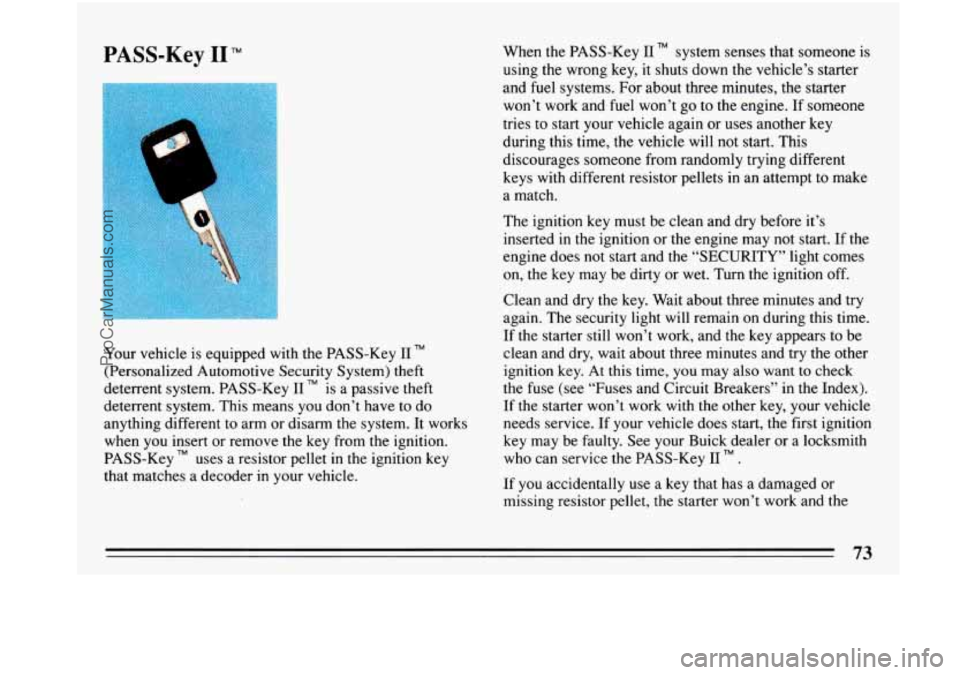
PASS-Key I1 TM
Your vehicle is equipped with the PASS-Key I1 TM
(Personalized Automotive Security System) theft
deterrent system. PASS-Key
I1 TM is a passive theft
deterrent system. This means you don’t have to do
anything different to arm or disarm the system. It works
when you insert or remove the key from the ignition.
PASS-Key
TM uses a resistor pellet in the ignition key
that matches a decoder in your vehicle. When the PASS-Key
I1 system senses that someone
using the wrong key, it shuts down the vehicle’s starter
and
fuel systems. For about three minutes, the starter
won’t work and fuel won’t go to the engine. If someonl
tries to start your vehicle again or uses another key
during this time, the vehicle will not start. This
discourages someone from randomly trying different
is
e
keys with different resistor pellets in an attempt to make
a match.
The ignition
key must be clean and dry before it’s
inserted in the ignition or the engine may not start. If the
engine does not start and the “SECURITY” light comes
on, the key may be dirty or wet. Turn the ignition
off.
Clean and dry the key. Wait about three minutes and try
again. The security light will remain on during this time.
If the starter still won’t work, and the key appears to be
clean and dry, wait about three minutes and try the other
ignition key.
At this time, you may also want to check
the fuse (see “Fuses and Circuit Breakers” in the Index).
If the starter won’t work with the other key, your vehicle
needs service. If your vehicle does start, the first ignition
key may
be faulty. See your Buick dealer or a locksmith
who can service the PASS-Key I1
TM .
If you accidentally use a key that has a damaged or
missing resistor pellet, the starter won’t work and the
ProCarManuals.com
Page 78 of 340
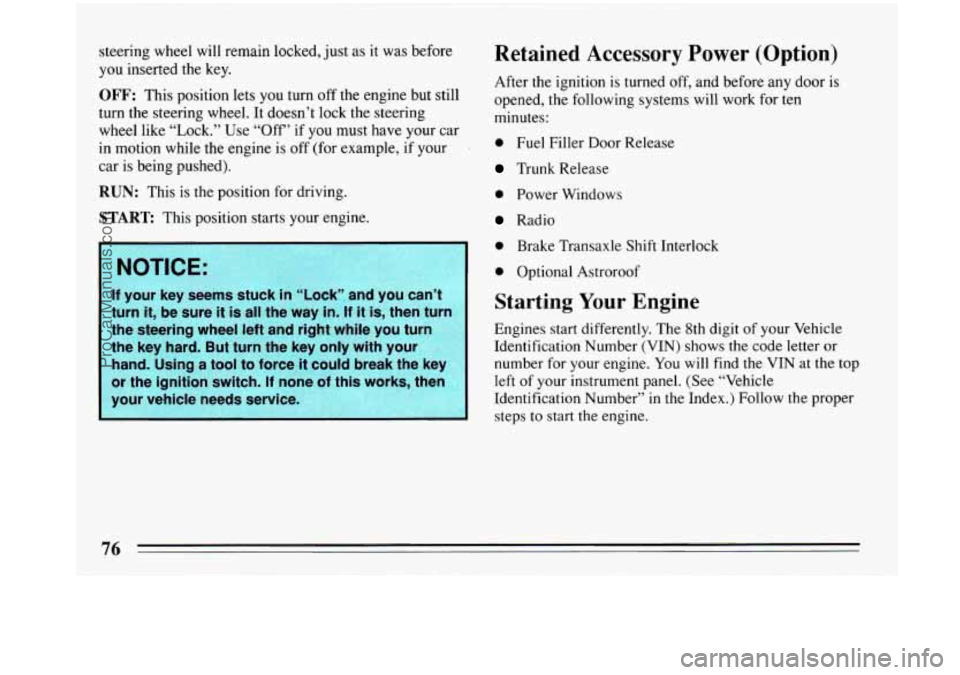
steering wheel will remain locked, just as it was before
you inserted the key.
OFF: This position lets you turn off the engine but still
turn the steering wheel.
It doesn’t lock the steering
wheel like “Lock.” Use “Off’ if
you must have your car
in motion while the engine is off (for example, if your
car is being pushed).
RUN: This is the position for driving.
START This position starts your engine.
NOTICE:
If your key seems stuck in “Lock” and you can’t
turn
it, be sure it is all the way in. If it is, then turn
the steering wheel left and right while you turn
the key hard. But turn the key only with your
hand. Using a tool to force
it could break the key
or the ignition switch. If none of this works, then
your vehicle needs service.
p’
Retained Accessory Power (Option)
After the ignition is turned off, and before any door is
opened, the following systems will work for ten
minutes:
0 Fuel Filler Door Release
Trunk Release
0 Power Windows
Radio
0 Brake Transaxle Shift Interlock
0 Optional Astroroof
Starting Your Engine
Engines start differently. The 8th digit of your Vehicle
Identification Number
(VIN) shows the code letter or
number for your engine. You will find the
VIN at the top
left of your instrument panel. (See “Vehicle
Identification Number” in the Index.) Follow the proper
steps to start the engine.
ProCarManuals.com
Page 81 of 340
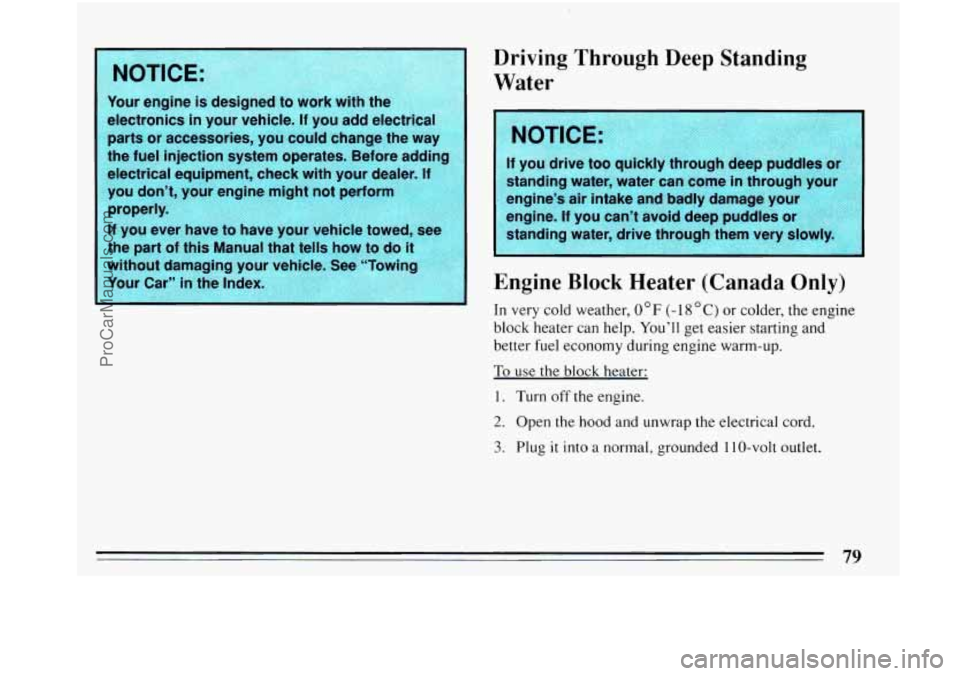
Driving Through Deep Standing
Water
standing water, water can come in through your
engine's air intake and badly damage your
engine.
If you can't avoid deep puddles or
standing water, drive through them very
s
Engine Block Heater (Canada Only)
In very cold weather, 0 " F (- 18 "C) or colder, the engine
block heater can help. You'll get easier starting and
better fuel economy during engine warm-up.
To use the block heater:
1. Turn off the engine.
2. Open the hood and unwrap the electrical cord.
3. Plug it into a normal, grounded 110-volt outlet.
ProCarManuals.com
Page 84 of 340
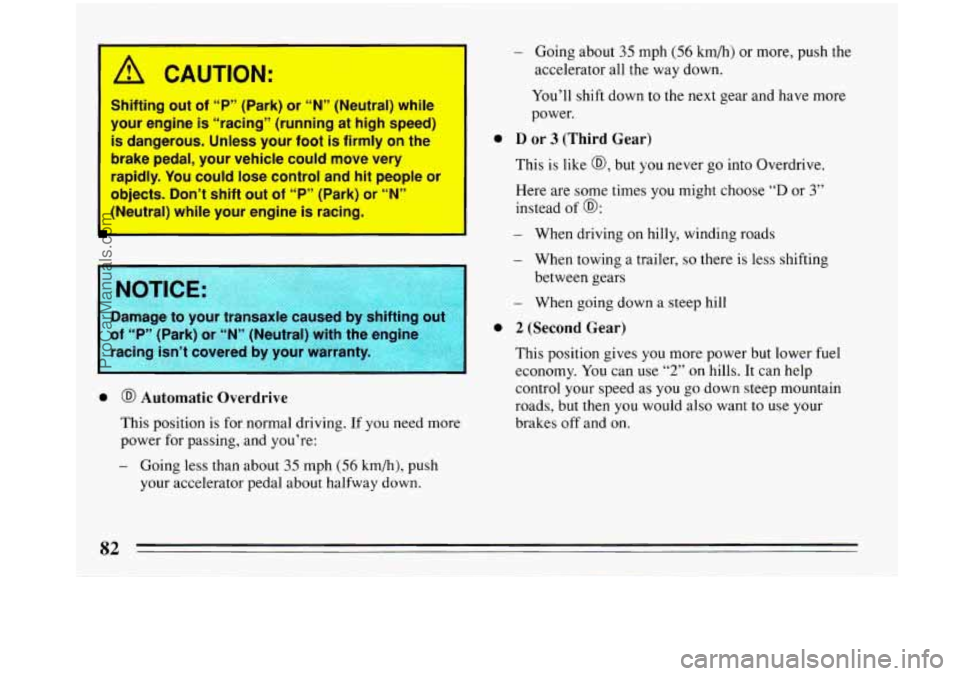
I
A CAUTION:
Shifting out of “PYy (Park) or “N” (Neutral) while
’ your engine is “racing” (running at high speed)
is dangerous. Unless your foot
is firmly on the
brake pedal, your vehicle could move very
rapidly. You could lose control and hit people or
objects. Don’t shift out of “P” (Park) or “N”
I (Neutral) while your engine is racing.
Damage to your tia,lsaxI
Going about 35 mph (56 km/h) or more, push the
accelerator all the way down.
You’ll shift down
to the next gear and have more
power.
0 D or 3 (Third Gear)
This is like @, but you never go into Overdrive.
Here are some times you might choose
“D or 3”
instead of @:
- When driving on hilly, winding roads
- When towing a trailer, so there is less shifting
between gears
- When going down a steep hill
0 2 (Second Gear)
This position gives you more power but lower fuel
economy. You can use
“2” on hills. It can help
control your speed as
you go down steep mountain
roads, but then you would also want to use your
brakes off and on. 0 @ Automatic Overdrive
This position is for normal driving. If you need more
power for passing, and you’re:
- Going less than about 35 mph (56 km/h), push
your accelerator pedal about halfway down.
82
ProCarManuals.com
Page 85 of 340
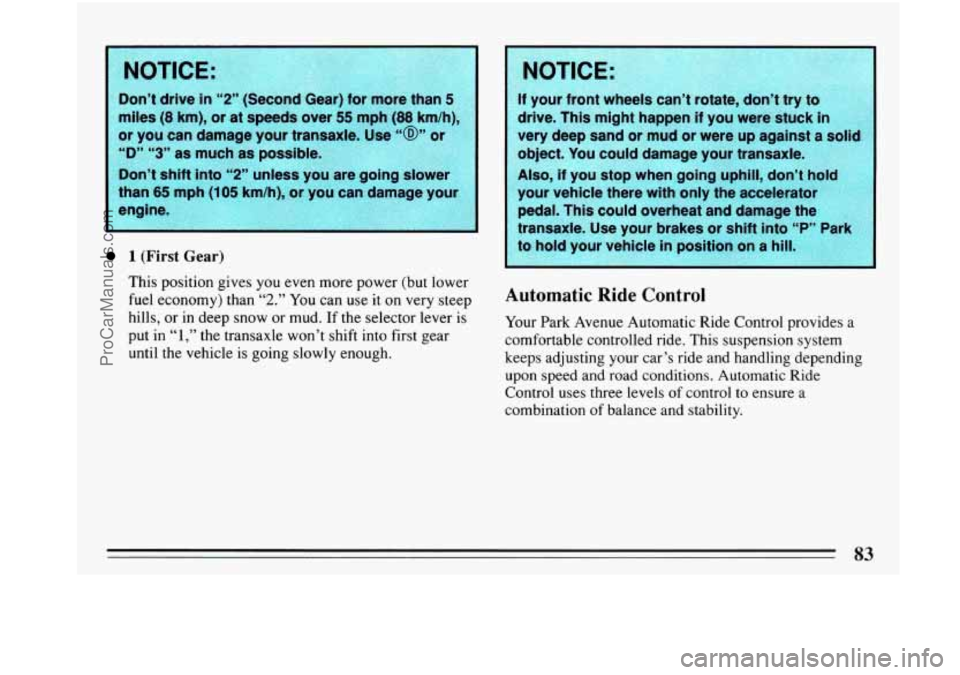
NOTICE: , * _. s*, ?x-&.
Don’t drive in “2” (Second Gear) for more than 5
miles (8 km), or at speeds over 55 mph (88 - km/h),
or you can damage your transaxle. Use
“@” 01
“D” “3” as much as possible
Don’t shift
into “2” unless you are going slower
than
65 mph (105 km/h), or you can damage your
1 (First Gear)
This position gives you even more power (but lower
fuel economy) than “2.” You can use it on very steep
hills, or in deep snow
or mud. If the selector lever is
put in
“1,” the transaxle won’t shift into first gear
until the vehicle is going slowly enough.
NOTICE:
If your front wheels can’t rotate, don’t try to
drive. This might happen if you were stuck in
very deep sand or mud or were up against a solid
object.
You could damage your transaxle.
Also, if you stop when going uphill, don’t hoW
your vehicle there with only the accelerator
pedal. This could overheat and damage
th
transaxle. Use your brakes or shift intc ‘‘D
to hold your vehicle in position on a
Automatic Ride Control
Your Park Avenue Automatic Ride Control provides a
comfortable controlled ride. This suspension system
keeps adjusting your car’s ride and handling depending
upon speed and road conditions. Automatic Ride
Control uses three levels
of control to ensure a
combination
of balance and stability.
83
ProCarManuals.com
Page 118 of 340
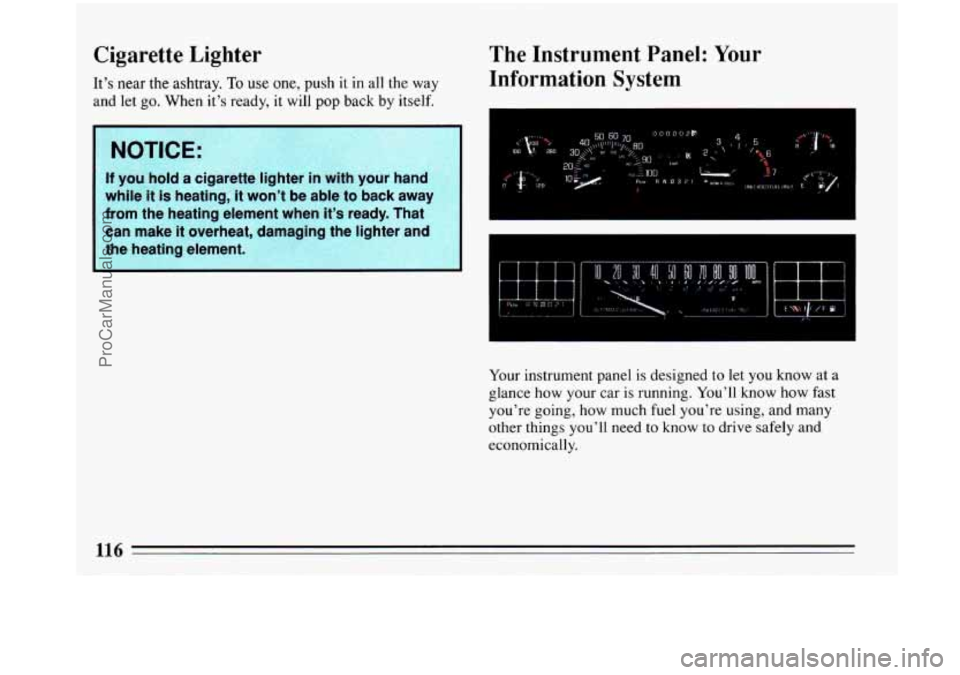
Cigarette Lighter The Instrument Panel: Your
Information System It's near the ashtray. To use one, push it in all the way
and let go. When it's ready, it will pop back by itself.
NOTICE:
If you hold a cigarette lighter in with your hand
while it is heating, it won't be able
to back away
from the heating element when it's ready. That can make it overheat, damaging the lighter and
the heating element.
Your instrument panel is designed to let you know at a
glance how your car is running. You'll know how fast
you're going, how much fuel you're using, and many
other things you'll need
to know to drive safely and
economically.
ProCarManuals.com
Page 120 of 340
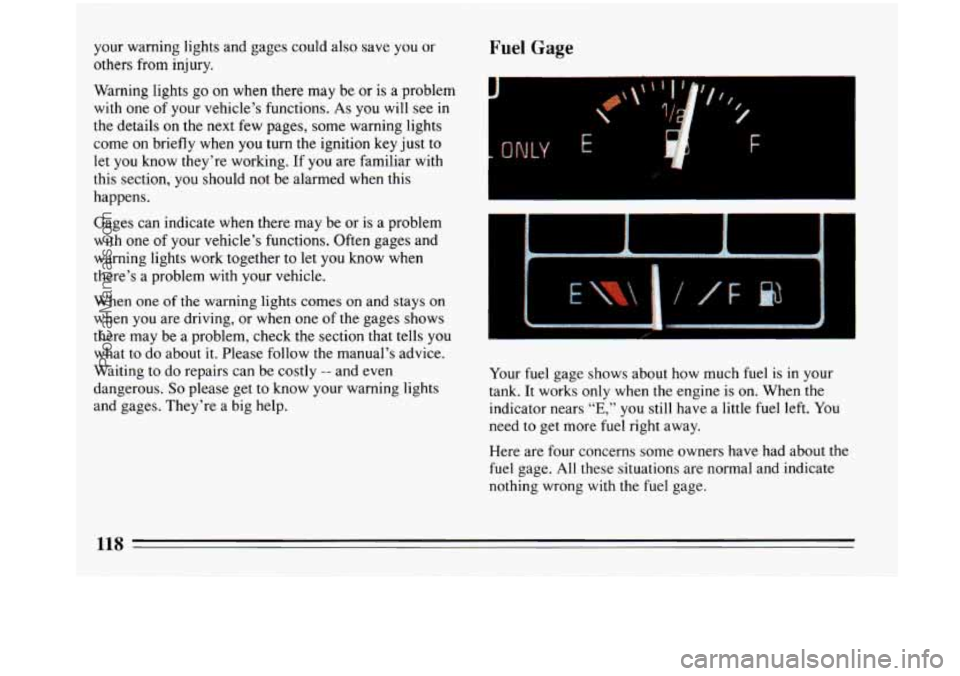
your warning lights and gages could also save you or
others from injury.
Warning lights go on when there may be or is a problem
with one of your vehicle’s functions.
As you will see in
the details on the next few pages, some warning lights
come on briefly when you turn the ignition key just to
let you know they’re working.
If you are familiar with
this section, you should not be alarmed when this
happens.
Gages can indicate when there may be or
is a problem
with one of your vehicle’s functions. Often gages and
warning lights work together to let you know when
there’s a problem with your vehicle.
When one
of the warning lights comes on and stays on
when you are driving, or when one of the gages shows
there may be a problem, check the section that tells you
what to do about it. Please follow the manual’s advice.
Waiting to do repairs can be costly
-- and even
dangerous.
So please get to know your warning lights
and gages. They’re a big help.
Fuel Gage
Your fuel gage shows about how much fuel is in your
tank. It works only when the engine is on. When the
indicator nears
“E,” you still have a little fuel left. You
need to
get more fuel right away.
Here are four concerns some owners have had about the
fuel gage. All these situations are normal and indicate
nothing wrong
with the fuel gage.
ProCarManuals.com
Page 121 of 340
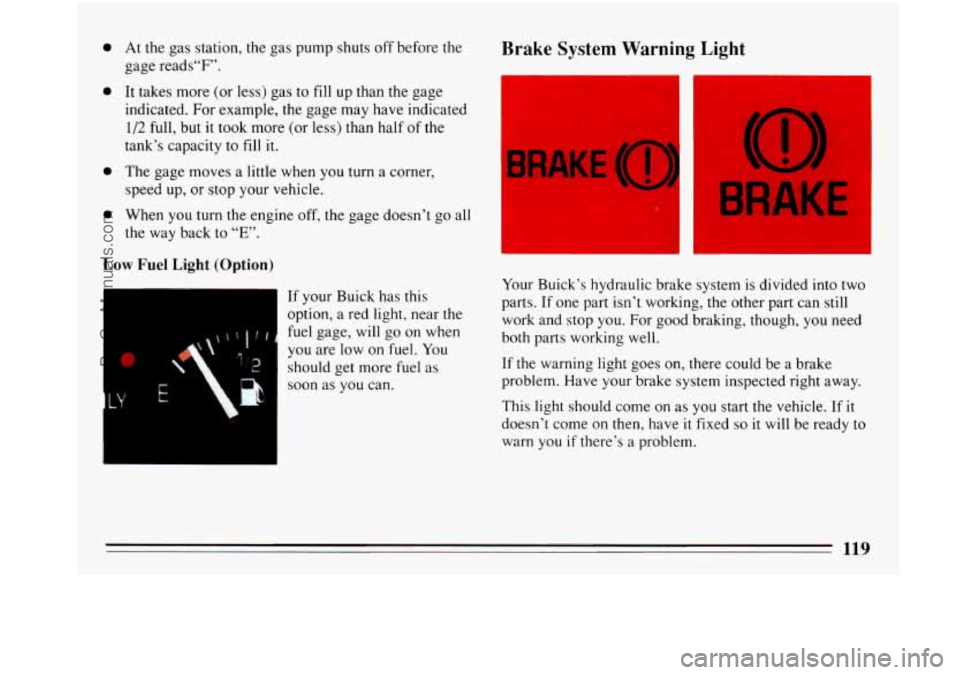
0
0
0
0
At the gas station, the gas pump shuts off before the
gage reads“F”.
It takes more (or less) gas to fill up than the gage
indicated. For example, the gage may have indicated
1/2 full, but it took more (or less) than half of the
tank’s capacity to fill it.
The gage moves a little when
you turn a corner,
speed up, or stop your vehicle.
When you turn the engine off, the gage doesn’t go all
the way back to
“E”.
Low Fuel Light (Option)
If your Buick has this
option, a red light, near the
fuel gage, will go on when
you are low on fuel.
You
should get more fuel as
soon as you can.
Brake System Warning Light
I
Your Buick’s hydraulic brake system is divided into two
parts. If one part isn’t working, the other part can still
work and stop you. For good braking, though,
you need
both parts working well.
If the warning light goes on, there could be a brake
problem. Have your brake system inspected right away.
This light should come
on as you start the vehicle. If it
doesn’t come on then, have it fixed so it will be ready to
warn you if there’s
a problem.
ProCarManuals.com
Page 128 of 340
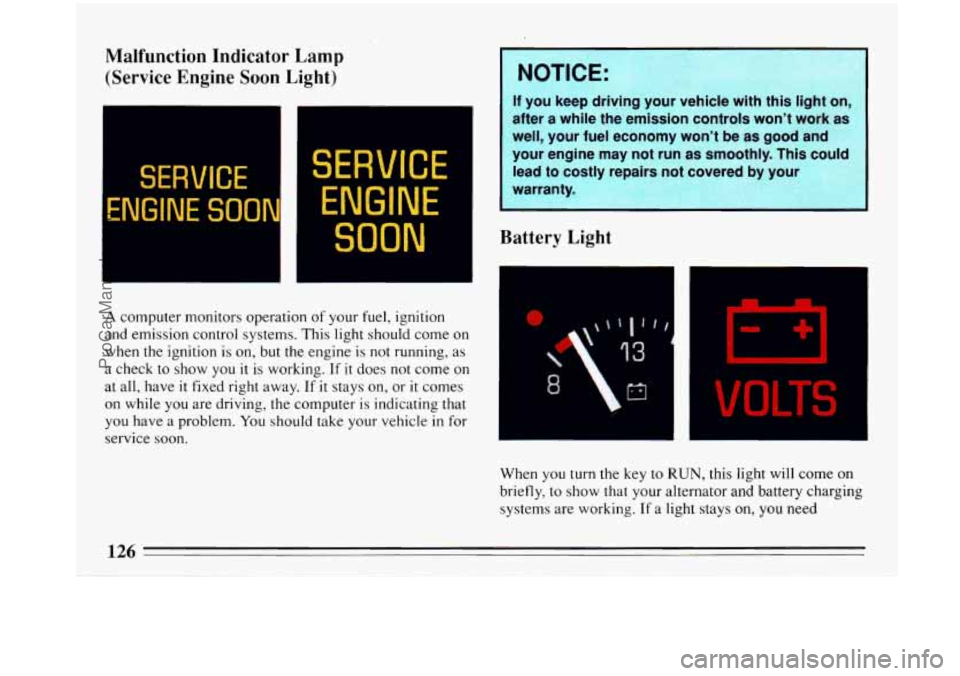
Malfunction Indicator Lamp
(Service Engine Soon Light)
SERVICE
ENGINE SO0
SERVICE
ENGINE
SOON
A computer monitors operation of your fuel, ignition
and emission control systems. This light should come on
when the ignition is on, but the engine is not running, as
a check to show you it is working. If it does not come on
at all, have
it fixed right away. If it stays on, or it comes
on while you are driving, the computer is indicating that
you have a problem. You should take your vehicle
in for
service soon.
NOTICE:
If you keep driving your vehicle with this light on-
after a while the emission controls won’t work as
1
well, your fuel economy won’t be as good and
your engine may not run as smoothly. This could
lead
to costly rer>airs not covered by your
warranty.
Battery Light
VOLTS
When you turn the key to RUN, this light will come on
briefly, to show that your alternator and battery charging systems are working. If a light stays
on, you need
126
ProCarManuals.com